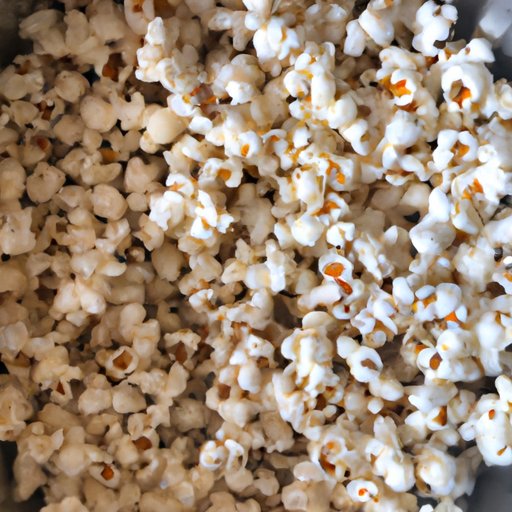I. Introduction
Popcorn is the perfect snack for movie nights, game nights, and any other occasion where you need a quick and easy snack. Making popcorn on the stove is a classic method for achieving the perfect texture and flavor. This article is aimed at beginners and experienced cooks alike, with the goal of providing a comprehensive guide to making perfect popcorn on the stove. We will cover everything from basic stovetop popcorn making to creative flavor combinations.
II. Step-by-Step Guide
Before you get started, make sure you have a heavy-bottomed pot with a tight-fitting lid. You will also need popcorn kernels, oil or butter, and whatever seasonings you like.
1. Turn your stovetop to medium heat and add oil or butter to your pot.
2. Add a few kernels of popcorn to the pot and wait until they pop. This will let you know that the oil or butter is hot and ready for the rest of the kernels.
3. Once the test kernels have popped, add the rest of the kernels in a single layer. Cover the pot with the lid and shake the pot gently back and forth to spread the kernels around evenly.
4. Within a few minutes, the kernels will start popping. Shake the pot occasionally to prevent burning and to make sure all kernels pop.
5. Once the popping slows down, remove the pot from the heat and carefully pour the popcorn into a large bowl.
6. Season the popcorn to taste with salt, butter, or any other seasonings you like.
Tip: For even better results, use a stovetop popcorn popper. These poppers have vents that allow steam to escape, resulting in perfectly popped kernels every time.
III. Oil Vs. Butter
The debate over whether to use oil or butter to make popcorn is ongoing. Oil is a healthier option, but butter is what most people are used to and gives the popcorn a delicious, creamy flavor.
For a healthier option, consider using coconut oil, which has an almost buttery flavor and is rich in healthy fats. Another option is to use a spray oil, which gives a light coating of oil without weighing down the popcorn.
For those who love butter, you can use it to add an extra layer of flavor to your popcorn. Melt the butter in a separate pan and pour it onto the popcorn when it’s done popping. You can also add herbs or spices to the melted butter for a unique taste.
IV. Flavor Boosters
Beyond salt and butter, there are so many ways to add flavor to your popcorn. Here are some of our favorite sweet and savory popcorn toppings:
– Caramel corn: mix together melted butter, brown sugar, and corn syrup and pour over the popcorn. Bake in the oven until the popcorn is crispy.
– Spicy popcorn: mix together chili powder, paprika, garlic powder, and cumin and sprinkle over the popcorn.
– Ranch seasoning: sprinkle ranch seasoning over the popcorn for a tangy flavor.
– Nutritional yeast: sprinkle nutritional yeast over the popcorn for a cheesy flavor that’s also vegan.
– Chocolate popcorn: melt chocolate chips and drizzle over the popcorn. It’s a sweet treat that will satisfy any sweet tooth.
V. Importance of Heat
The temperature of your stove is crucial when it comes to making stovetop popcorn. Too high heat can burn the kernels, while too low heat can result in many un-popped kernels.
If you have a gas stove, use medium heat. Electric stoves require a little more care – the high heat setting is usually too high, so start with medium heat and gradually increase if needed.
To ensure consistent heat throughout cooking, consider using a heat diffuser. These are available in many cooking stores and help distribute heat evenly throughout your pot.
VI. Stovetop Popcorn Poppers
Stovetop popcorn poppers are an excellent option for those who make popcorn regularly. These poppers have vents in the lid that allow steam to escape, resulting in perfectly popped kernels every time.
There are a few different types of stovetop popcorn poppers to choose from, including whirly poppers and traditional poppers. Both types work well, and the decision comes down to personal preference.
Whirly poppers have a crank that you turn manually to keep the kernels moving and prevent burning. Traditional poppers have a long handle that you shake to move the kernels around.
Tip: When using a stovetop popcorn popper, be sure to follow the manufacturer’s instructions for best results.
VII. Healthier Popcorn
Popcorn can be a healthy snack if done right. Here are some tips for making stovetop popcorn a healthier option:
– Use coconut oil or spray oil instead of butter.
– Choose air-popped popcorn. You can use an air popper or pop it in the microwave with a brown paper bag.
– Use nutritional yeast instead of traditional cheese flavoring.
– Add spices or herbs for unique, healthy flavorings.
VIII. Troubleshooting Tips
Even experienced popcorn makers can make mistakes. Here are some tips for troubleshooting common stovetop popcorn problems:
– If your popcorn is burning, try lowering the heat slightly and shaking the pot more often.
– If your popcorn isn’t popping, you may not have the temperature high enough – try turning up the heat.
– If you have a lot of unpopped kernels, you may not be shaking the pot enough to distribute the kernels evenly.
If you accidentally burn your popcorn, don’t throw it away! Crush it up and use it as a crunchy topping for salads or casseroles.
IX. Conclusion
Making popcorn on the stove is a classic cooking technique that everyone should try at least once. With the right tools and ingredients, anyone can achieve perfectly popped, delicious popcorn. Whether you prefer to use oil or butter, or sweet or savory seasonings, there’s no limit to the flavor possibilities with stovetop popcorn.
